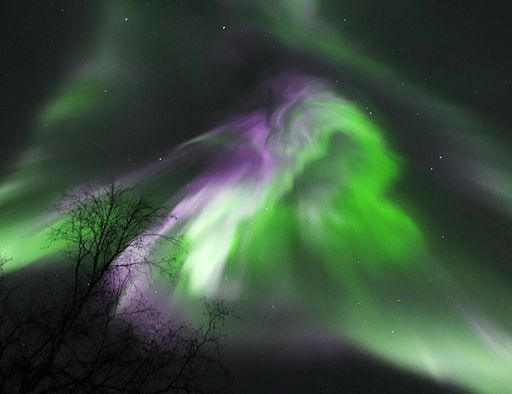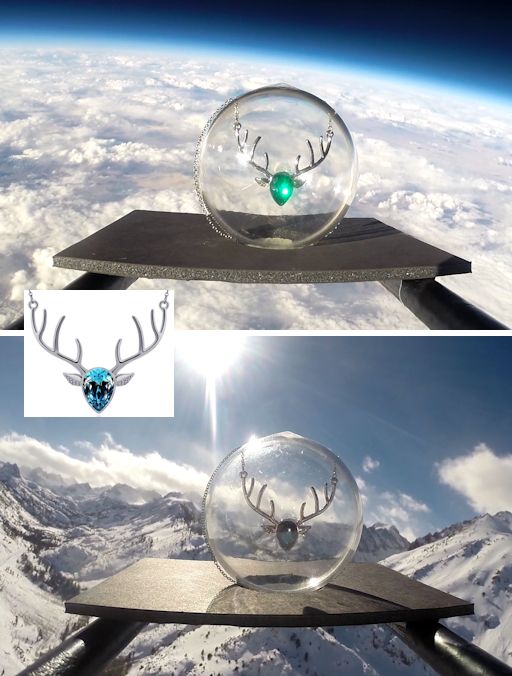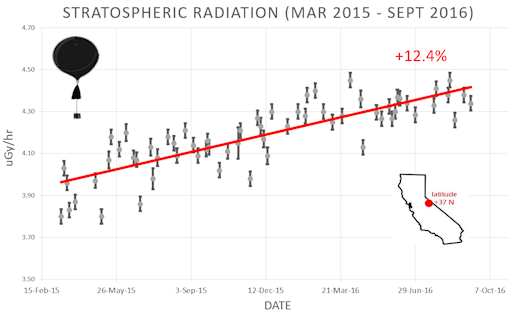Directly under the Arctic Circle! Marianne's Arctic Xpress in Tromsø offers fjord, whale and wildlife tours by day, aurora tours by night. Book Now for out of this world day and night adventures. | | | GEOMAGNETIC STORM: A polar geomagnetic storm is in progress as Earth enters a fast-moving stream of solar wind. This is sparking bright auroras around the Arctic Circle. The solar wind is flowing from a large canyon-shaped hole in the sun's atmosphere and is expected to influence Earth for the next two days. Free: Aurora alerts.
First contact with the stream on March 1st caused an outburst of green and purple lights above Alaska. Ayumi Bakken was in the countryside near Fairbanks on March 1st when he took this picture: 
"What an amazing show tonight," says Bakken. "Just after a winter storm passed, the magnetic storm began and Lady Aurora danced overhead." Earth is moving deeper into the stream, and wind speeds could top 700 km/s before the day is over. Arctic sky watchers should remain alert for auroras on Mar. 1-2 as NOAA forecasters estimate a 60% chance of continued polar geomagnetic storms. Realtime Aurora Photo Gallery A NEW KIND OF SPACE WEATHER BALLOON: The students of Earth to Sky Maritime (a franchise of Earth to Sky Calculus) have built a space weather balloon payload that does something new: it floats! On Feb. 14th they launched the pipe-shaped payload from Calistoga, California. After a 2.5 hour trip to the stratosphere, the floating cylinder parachuted back to Earth and splashed down in the San Pablo Bay northeast of San Francisco. 
A team of student mariners recovered the payload from the deck of the Cub, a tug boat operated by Cal Maritime. Not everything went perfectly. The payload's camera popped off at the moment of landing and sank to the bottom of the Bay--so no images from the stratosphere. Otherwise, the launch, tracking and recovery were a big success.
This development will allow us to start launching space weather balloons from places on Earth where the possibility of a water landing previously forbid such missions. The students of Earth to Sky Maritime already have one such place in mind: from South Carolina during the August 21, 2017, total solar eclipse. They plan to photograph the eclipse from the stratosphere over Charleston and recover the payload later from the Atlantic after the Moon's shadow passes by. Realtime Solar Eclipse Photo Gallery ARCTIC SPACE REINDEER: The students of Earth to Sky Calculus are about to travel inside the Arctic Circle (Abisko, Sweden) for their first polar space weather balloon launch. To raise money for the trip, on Feb. 23rd they flew a payload-full of Arctic reindeer pendants to the edge of space: 
You can have one for $129.95. Each glittering pendant comes with a greeting card showing the jewelry in flight and certifying that it has been to the stratosphere and back again. These pendants make great Birthday and Mother's Day gifts. Bonus: Would you like your pendant to be flown over the Arctic as well? Make a note to that effect in the COMMENTS box at checkout, and we will take your pendent to Sweden for a second trip to the stratosphere. Realtime Space Weather Photo Gallery
Realtime Comet Photo Gallery
Every night, a network of NASA all-sky cameras scans the skies above the United States for meteoritic fireballs. Automated software maintained by NASA's Meteoroid Environment Office calculates their orbits, velocity, penetration depth in Earth's atmosphere and many other characteristics. Daily results are presented here on Spaceweather.com. On Mar. 1, 2017, the network reported 6 fireballs.
(6 sporadics)  In this diagram of the inner solar system, all of the fireball orbits intersect at a single point--Earth. The orbits are color-coded by velocity, from slow (red) to fast (blue). [Larger image] [movies] Potentially Hazardous Asteroids ( PHAs) are space rocks larger than approximately 100m that can come closer to Earth than 0.05 AU. None of the known PHAs is on a collision course with our planet, although astronomers are finding new ones all the time. On March 1, 2017 there were potentially hazardous asteroids. Notes: LD means "Lunar Distance." 1 LD = 384,401 km, the distance between Earth and the Moon. 1 LD also equals 0.00256 AU. MAG is the visual magnitude of the asteroid on the date of closest approach. | | Cosmic Rays in the Atmosphere |
Readers, thank you for your patience while we continue to develop this new section of Spaceweather.com. We've been working to streamline our data reduction, allowing us to post results from balloon flights much more rapidly, and we have developed a new data product, shown here: 
This plot displays radiation measurements not only in the stratosphere, but also at aviation altitudes. Dose rates are expessed as multiples of sea level. For instance, we see that boarding a plane that flies at 25,000 feet exposes passengers to dose rates ~10x higher than sea level. At 40,000 feet, the multiplier is closer to 50x. These measurements are made by our usual cosmic ray payload as it passes through aviation altitudes en route to the stratosphere over California. What is this all about? Approximately once a week, Spaceweather.com and the students of Earth to Sky Calculus fly space weather balloons to the stratosphere over California. These balloons are equipped with radiation sensors that detect cosmic rays, a surprisingly "down to Earth" form of space weather. Cosmic rays can seed clouds, trigger lightning, and penetrate commercial airplanes. Furthermore, there are studies ( #1, #2, #3, #4) linking cosmic rays with cardiac arrhythmias and sudden cardiac death in the general population. Our latest measurements show that cosmic rays are intensifying, with an increase of more than 12% since 2015: 
Why are cosmic rays intensifying? The main reason is the sun. Solar storm clouds such as coronal mass ejections (CMEs) sweep aside cosmic rays when they pass by Earth. During Solar Maximum, CMEs are abundant and cosmic rays are held at bay. Now, however, the solar cycle is swinging toward Solar Minimum, allowing cosmic rays to return. Another reason could be the weakening of Earth's magnetic field, which helps protect us from deep-space radiation. The radiation sensors onboard our helium balloons detect X-rays and gamma-rays in the energy range 10 keV to 20 MeV. These energies span the range of medical X-ray machines and airport security scanners. The data points in the graph above correspond to the peak of the Reneger-Pfotzer maximum, which lies about 67,000 feet above central California. When cosmic rays crash into Earth's atmosphere, they produce a spray of secondary particles that is most intense at the entrance to the stratosphere. Physicists Eric Reneger and Georg Pfotzer discovered the maximum using balloons in the 1930s and it is what we are measuring today. | | The official U.S. government space weather bureau | | | The first place to look for information about sundogs, pillars, rainbows and related phenomena. | | | Researchers call it a "Hubble for the sun." SDO is the most advanced solar observatory ever. | | | 3D views of the sun from NASA's Solar and Terrestrial Relations Observatory | | | Realtime and archival images of the Sun from SOHO. | | | from the NOAA Space Environment Center | | | a proud supporter of science education and Spaceweather.com | | | fun to read, but should be taken with a grain of salt! Forecasts looking ahead more than a few days are often wrong. | | | from the NOAA Space Environment Center | | | the underlying science of space weather | | | These links help Spaceweather.com stay online. Thank you to our supporters! |  | Beautyz for top beauty products reviews and their buying guides | | | These links help Spaceweather.com stay online. Thank you to our supporters! | | 
